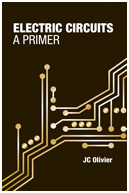
Did you sleep through your sophomore year core EE classes? At the time, you probably never thought you would need to know about Thevenin circuits, why equivalent resistance is calculated by making voltage sources shorts and current sources opens, or why the transient response of a critically damped RLC circuit is in the form of an exponential decay and a ramp times an exponential decay.
Now that you’ve been in industry some years, you realize the significance of these simple, basic fundamental principles. It’s too late to go back to school, but it’s not too late to brush up on these essential building block principles for all electrical engineers. You now have a second chance to stir up your brain cells and review core electrical engineering concepts typically covered in a first semester sophomore class.
Electric Circuits by JC Oliver is not designed to be a stand-alone course, but a refresher and quick review course. You can probably skip over the first few chapters on voltage, current, resistance, KCL and KVL and jump into Chapter 8 on using superposition to analyze circuits.
The concept of an equivalent Thevenin voltage and resistance circuit is the most important model I use over and over again to describe any signal source. Yet as I travel around the world lecturing to professional engineers, I am constantly amazed how many engineers don’t really understand this important model. If you are one of these, this book is the perfect refresher for you.
After you browse Chapter 9, you should continue along to Section II on the transient response of RC, RL and RLC circuits. Oliver takes the traditional approach of analyzing the natural response and then focuses on the step response of these circuits. Where he deviates from the transitional approach is by covering the transient analysis before the frequency domain analysis.
Section III is the phasor approach and complex impedance, describing the same RLC circuits in the frequency domain. Using the voltage divider approach, he motivates the description of the transfer function of a circuit as a filter in the frequency, and finally Bode Plots, all without introducing LaPlace transforms.
In each chapter that introduces the principles the next chapter walks the reader through a selection of worked examples. Unlike a typical dense textbook, this book’s format is simple and uncluttered, ideal for quick skimming to find the nugget you are looking for.
Now that you have been working in industry for some years, you know what you regret not learning when you had the chance. This book is your second chance.
Use the code SIJ25 at www.artechhouse.com to receive 25% off print books (Cannot be combined with any other discount offers or used for eBooks. Expires Dec 31, 2019).
Artech House is a division of Horizon House Publications, Inc., the parent company for Signal Integrity Journal.


